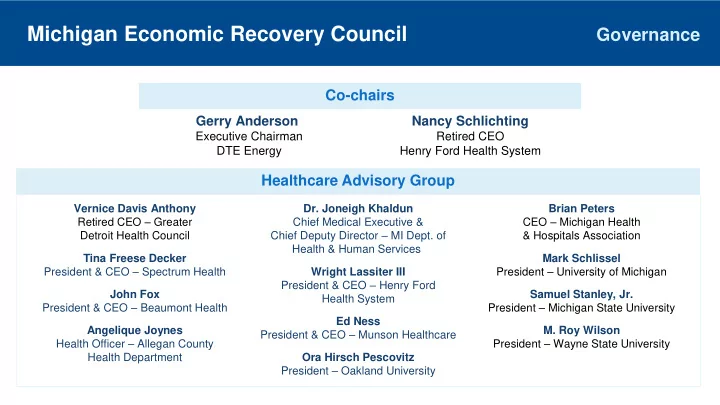

Michigan Economic Recovery Council Governance Co-chairs Gerry Anderson Nancy Schlichting Executive Chairman Retired CEO DTE Energy Henry Ford Health System Healthcare Advisory Group Vernice Davis Anthony Dr. Joneigh Khaldun Brian Peters Retired CEO – Greater CEO – Michigan Health Chief Medical Executive & Chief Deputy Director – MI Dept. of Detroit Health Council & Hospitals Association Health & Human Services Tina Freese Decker Mark Schlissel President & CEO – Spectrum Health President – University of Michigan Wright Lassiter III President & CEO – Henry Ford John Fox Samuel Stanley, Jr. Health System President & CEO – Beaumont Health President – Michigan State University Ed Ness Angelique Joynes M. Roy Wilson President & CEO – Munson Healthcare Health Officer – Allegan County President – Wayne State University Health Department Ora Hirsch Pescovitz President – Oakland University
Michigan Economic Recovery Council Governance Business Advisory Group Mary Barra Rory Gamble Blake Krueger Chairman & CEO President Chairman, President & CEO General Motors UAW Wolverine World Wide Ron Bieber Milan Gandhi Ryan Maibach President Med-Share & Chairman President Michigan AFL-CIO Small Business Association of Michigan Barton Malow Jeff Donofrio Ron Hall, Jr. Andi Owen Director President & CEO President & CEO Michigan Department of Bridgewater Interiors Herman Miller Labor & Economic Opportunity Jim Keane Ray Scott Jay Farner President & CEO President & CEO CEO Steelcase Lear Quicken Loans Rick Keyes Gary Torgow Jim Fitterling President & CEO Chairman CEO Meijer TCF Financial Dow
Framework for making return to work decisions Recovery Essentially all segments All segments open open (with certain high- risk with best practices All segments open exceptions) with best in place practices in place Pandemic Risk Stabilizing Selective reopening, Broader reopening Consider reopening but only if disciplined best with best practices essentially all practices certified in place low-risk segments Urgent Consider reopening Critical industries only Critical industries only segments with extremely low risk High Medium Low Workplace Risk
Michigan Economic Recovery Council Reporting Regions MERC Regions Population % of total 8 1 Detroit Region 5,243,543 52.5% 1,535,115 2 Grand Rapids Region 15.4% 3 Kalamazoo Region 964,202 9.7% 4 6 Saginaw Region 606,319 6.1% 5 Lansing Region 591,102 5.9% 4 6 Traverse City Region 445,159 4.5% 2 Jackson Region 302,566 3.0% 7 5 8 Upper Peninsula 298,851 3.0% 1 3 9,986,857 Total Michigan 100.0% 7 1. Containment differs by region and ranges from ~90% containment in region 1 and ~60% containment in region 5
Cases for MERC Region 1,000,000 Michigan Region 1 1 100,000 2 Region 2 Region 3 3 10,000 Region 4 4 1,000 5 Region 5 Region 6 6 100 7 Region 7 Region 8 8 Day 10 0 3 6 9 12 16 20 24 28 32 36 40 44 48 Daily case doubling rate (in days) 1 23 2 Statewide 2 3 2 2 3 4 7 13 17 27 23 1. Day 0 represents the point at which a region first reached 10 cases. Last statewide case doubling data represents day 41
The key indicators of readiness for economic restart Flatten the curve Epidemic A Density and trajectory of spread spread B Community exposure / immunity Critical personnel A Safely diagnose Healthcare system B Beds and treat patients capacity C Ventilators D PPE Track and A Public health Infrastructure contact tracing capacity isolate contacts B Effective isolation / quarantine
Michigan’s labor force by workplace Office Workers are tied to other workplace types 29% Industrial 19% Large, medium and small industrial Healthcare Hospital and outpatient healthcare 13% Retail 12% Big box and smaller retailers Restaurant & Lodging From large chains to single proprietors 8% Schools K-12 and Higher Education 6% Construction Commercial and residential construction 4% Outdoor A range of outdoor occupations 4% Other A wide variety of smaller jobs/facilities 4%
Occupation specific transmission risk boils down to… Risk factors Worker a Interaction with general public (sustained or intermittent) b interaction Contact with fellow coworkers in normal course of work c Shared tooling / machinery d Indoor / Outdoor Workplace e Number of workers f Worker density (number per square foot active workspace) characteristics g Required travel h Basic industrial hygiene (sanitation facilities, airflow, etc.) Worker Demography i Preexisting conditions j type Contact outside of work k Transit options l Immunity m
Workplace best practices have been rapidly developed for the 9 workplace types Best-practice risk mitigation strategies fall into five buckets Sanitation / Contact tracing / Access control Social distancing PPE Hygiene Isolation •Daily “symptom • Remote work • Frequent disinfection / • Masks • Investigation diaries” (mandatory standards cleaning of facilities standards • Gloves questionnaires and equipment • Restrictions on • Isolation protocols concerning symptoms) • Face shields • Availability of common areas • Notification protocols • On-site temperature like cafeterias, handwashing facilities • Gowns (HR, first responders, checks break rooms and • Restrictions on shared government conference rooms • Rapid diagnostic tooling / machinery authorities) • Restrictions testing protocols • HEPA filters on • Quarantine and on in-person • Intake procedure HVAC units return-to-work meeting size for visitors guidelines • Local exhaust • Physical barriers • Guidelines for • Facility cleaning / ventilation between workspaces delivery areas shutdown procedure • Restrictions on travel and non-essential external meetings
Framework for making return to work decisions Recovery Essentially all segments All segments open open (with certain high- risk with best practices All segments open exceptions) with best in place practices in place Pandemic Risk Stabilizing Selective reopening, Broader reopening Consider reopening but only if disciplined best with best practices essentially all practices certified in place low-risk segments Urgent Consider reopening Critical industries only Critical industries only segments with extremely low risk High Medium Low Workplace Risk
Recommend
More recommend